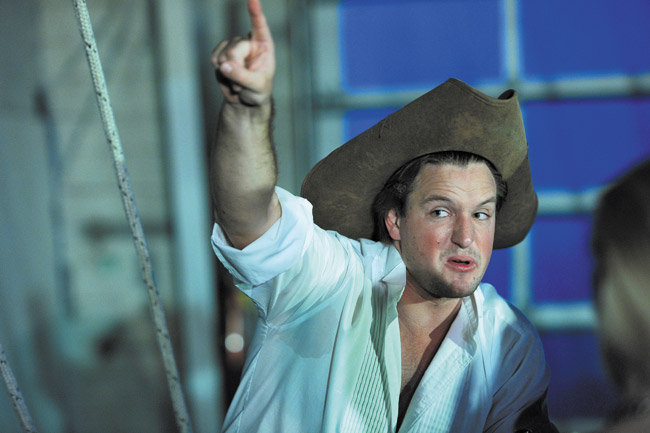Opera Gets Physical
A ghostly captain seeking redemption through true love, his female admirer, her jilted suitor, along with her money-driven dad and her nursemaid, were all in Kakaako last week. If that sounds like a quintet of characters, it’s the five principal cast-members of Hawaii Opera Theatre’s The Flying Dutchman. They were represented by local chorus volunteers at a HOT preview night where a packed room got some first-person knowledge about each character and a firsthand look at clusters of hanging rope that help make the Dutchman set and choreography so visually gripping.
mw-art-02042015-dutchman-lt001
“Everybody at some point climbs up onto the ratlines or onto the stage to use the ropes,” notes choreographer Eric Sean Fogel. “In the opening scene, sailors use the ropes as if they’re on a ship and they’re trying to bring their tall ship home in the middle of a storm. In the second act, women use the ropes as if they’re creating them in a factory, to provide for their men on the ship. And in the third act, we see all the ghosts who hang from the ropes and the ratlines, which ultimately lead to the death of the lead female ― we use the ropes to kill her.”
The leads and others not only sing their operatic hearts out, but they do it while climbing about the stage and hanging from ropes and bars, all while costumed in layers of skirts, petticoats and sailor wear, not to mention boots. Oh, and yes, the fair maiden does expire, but there’s something about opera where it’s all in the journey, which is perchance enhanced by knowing the ending.
Visualize a raked stage, sloped like a ship, with bodies clasping ropes and climbing ratlines, like the grid of ropes in a playground or leading to the crow’s nest in a ship. The set, which was shipped over from New York’s Glimmerglass Festival, lends itself to gymnastic choreography. The production itself and much of the lead cast and production team, also are the same as at Glimmerglass 2013.
In addition to the principals, 50 local choristers (three generations’ worth) and eight dancers round out the cast, creating Dutchman’s community, which revolves around the 140 hanging ropes of varying lengths and diameter. Rope is central to the production’s sense of community, from the women who spin it to the men who sail with it. As Fogel points out, it’s an element for survival, yet it contributes to the heroine’s death.
“In Wagner operas,” he says, “you can find multiple layers which help you explore the story better. I think Francesca Zambello, the original (Glimmerglass) director, found that within the textures of the rope.”
Fogel was the original choreographer and he makes a reprise here in Hawaii, but with some artistic updates.
“A second path in any art form is a good thing,” he says. “I love to adjust the choreography based upon who’s in the room and what the actors are bringing, so quite often I’ll change things to bring out better performances, and I’ll fix certain things to help the storytelling come across even better.”
He adds that the move toward performer physicality and interactive sets is a trend with opera:
“I think a majority of operas are becoming more physical and more active. Opera is changing to compete with the demand of media and entertainment, where audiences are visually stimulated on a much faster pace. I will say, however, that it is uncommon to have a lead soprano (Melody Moore as Senta) or our bass (Ryan McKinny as the Dutchman) willing to climb and be as physical as they are. Both Melody and Ryan love to go around and climb and sing and create these fantastic images. They’re really a dream for any director or choreographer.”
This shipshape tale of tragic love, penned by Wagner after a stormy sea journey of his own, arrives at Blaisdell just in time for Valentine’s Day.
the TICKET stub
FLYING DUTCHMAN
When: Feb. 13, 15, 17
Where: Blaisdell Concert Hall
Cost: $34-$135
More Info: 596-7858 or hawaiiopera.org






